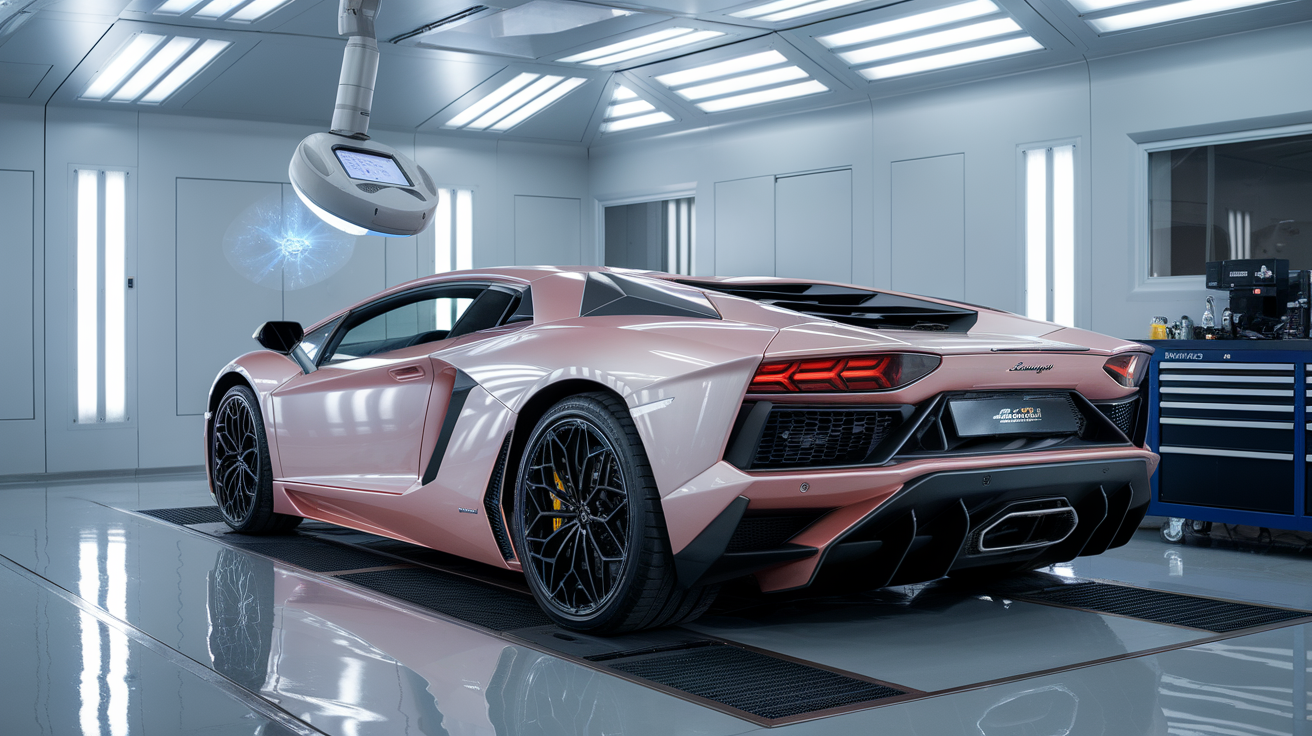Ever tried fixing a Ferrari the same way you’d fix a Toyota Corolla? Not a chance. What works for regular sedans falls apart, sometimes literally, when you’re dealing with low-clearance carbon fiber panels, delicate aluminum frames, or multi-million dirham builds. These machines are built differently, and so are the tools required to bring them back to life.
In a busy Dubai supercar garage, the stakes are not just high, they’re precision-milled. Every inch of a damaged body panel must be reshaped using Supercar Body Shop Tools built to read the lines of a McLaren or hug the curves of a Bugatti. Anything less can turn a prestige project into a costly mess. This page breaks down 12 Supercar Body Shop Tools that are not just for show; they are mission-critical. We use them daily to restore rare builds, from Aventadors to Koenigseggs, and believe us, not a single wrench here belongs in a sedan bay. In Dubai, you are not fixing daily drivers. You’re rebuilding dreams.
Why Supercar Body Shop Tools Matter?
If you’re in Dubai and someone hands you a damaged Rolls-Royce Wraith, you cannot just grab the same panel puller you use on a Honda Civic. You pause. You breathe. You walk over to that corner of the workshop, the one where the real tools live.
Here’s the hard truth: regular body shop tools just do not cut it. Supercars are not just vehicles; they are lightweight, performance-obsessed sculptures. The metals are thinner, stronger, and harder to manipulate. The panels? Often carbon fiber, bonded or riveted, not bolted. The paint? Multi-layered, candy-coated, factory-calibrated with precision spectrometers.
That is why Supercar Body Shop Tools exist. They’re built to handle tight tolerances, odd geometries, and rare materials. A single misaligned scan or over-torqued rivet can ruin a 92,000 AED fender, and we are not even exaggerating. Let’s break it down with honesty
- A Lamborghini panel cannot be reshaped with force. It needs a laser-guided jig.
- Carbon fiber delamination cannot be fixed with heat. It requires vacuum-infused resin tools.
- You cannot eyeball frame damage on a McLaren. You need a digital measuring bench that scans within 0.5mm variance.
Supercar Body Shop Tools are not a luxury; they are survival equipment in this business. Try explaining to a client why their 1.1 million AED Aston Martin’s hood now creaks. You won’t get a second chance. In a city like Dubai, where exotic vehicle repair is a full-time industry, the gap between right and wrong is measured in microns. When we say we’ve invested in specialized collision tools, we mean tools built to handle vehicles that think they’re airplanes. Ready to see the lineup? The next section breaks down the categories that matter.
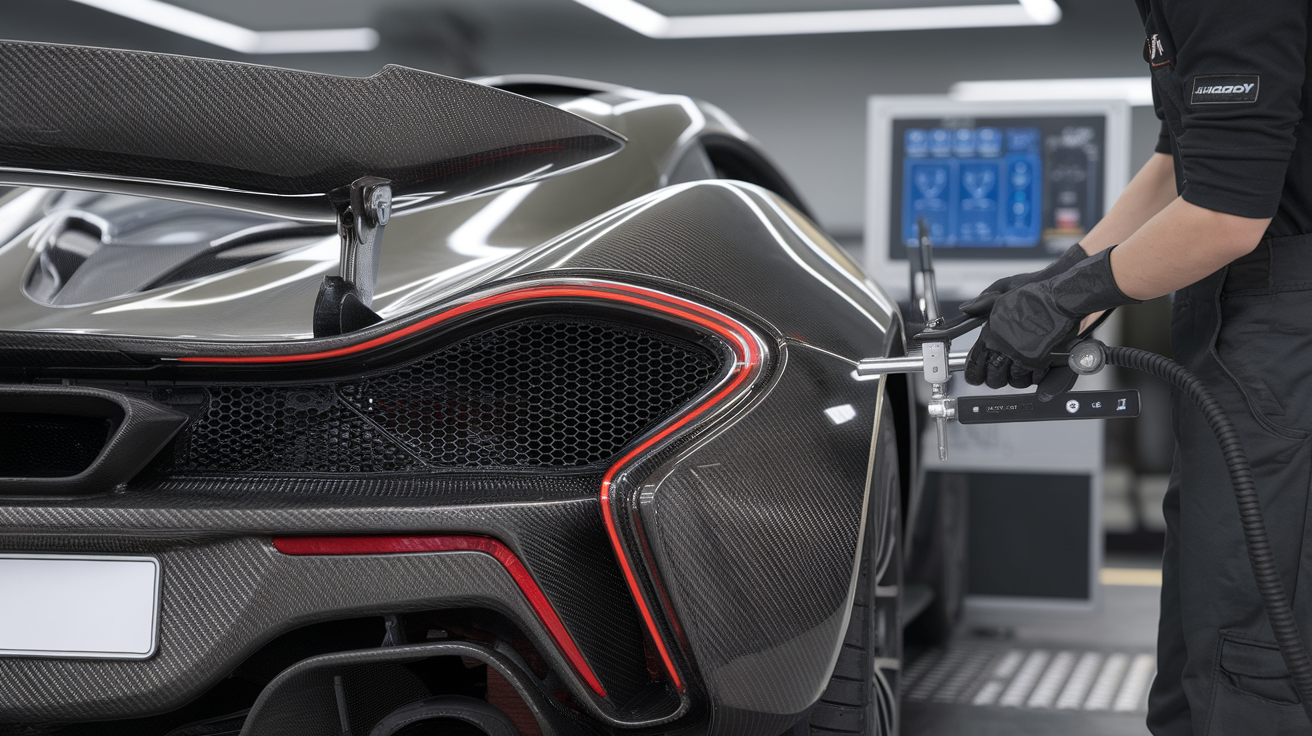
What Makes These Super Car Tools So Different?
You walk into a regular body shop. There’s noise, dust, maybe a sedan up on a lift. Now, walk into a supercar repair bay in Dubai. It feels… quieter. Focused. Almost surgical. Why? Because the tools in use are not meant for volume, they’re designed for precision.
We’re not just talking about stronger tools, we’re talking about a completely different breed of equipment. Supercar Body Shop Tools are engineered to handle magnesium alloys, exotic carbon fiber panels, and ultra-light monocoque frames that react badly to overcorrection. You touch the wrong seam the wrong way? It is not bending, it is cracking.
In Dubai’s high-end garages, Supercar Body Shop Tools are part of the workflow, not just gear in the background. They’re purpose-built to adapt to the materials and tolerances used in vehicles that are often worth more than a beachside villa. To keep it clear, here’s a breakdown of the core categories of Supercar Body Shop Tools we use daily
- Structural Tools | Alignment benches, laser jigs, scanner racks
- Composite Repair Tools | Vacuum bagging systems, infusion pumps, UV bonders
- Welding & Riveting Equipment | Aluminum welders with feedback control, low-torque rivet guns
- Panel Prep Systems | Clean-room sanding booths, dust-extraction orbital sanders
- Paint Correction Gear | High-RPM orbital polishers, heat-cure ceramic coating lamps
- Digital Measuring Devices | Frame scanners, panel fitment lasers, color-matching spectrometers
These categories are not upgrades. They’re requirements, especially when the vehicle on your lift could be a Bugatti Chiron or a Koenigsegg Jesko. If you’re using generic tools on a Ferrari, you’re not fixing it. You’re compromising it. Next up, we dive into the 12 specific tools that make it all possible, what they do, how they’re used, and why they never belong in a regular sedan bay. For a closer look at our supercar workflow in Dubai, visit Dubai Car Body Shop.
12 Supercar Body Shop Tools Built for Precision – Not Guesswork
You cannot walk into a supercar repair bay and expect a one-size-fits-all toolkit to handle the job. These are not everyday sedans. These are high-compression, wind-tunnel-tested, million-dirham machines. And they do not forgive mistakes.
In Dubai, where rare Lamborghinis and McLarens cruise Sheikh Zayed Road daily, your body shop either has the right tools, or you are not in the game. This section breaks down 12 Supercar Body Shop Tools we rely on to do things by spec, by science, and by experience. Every tool listed here is in use. Every tool has earned its place. Let’s start with the backbone of structural repair…
1 | Ultra-Precision Frame Alignment Rack
You cannot realign a Ferrari or Aston Martin with a manual rack. This tool scans the chassis using laser datum points and maps the structure with exacting accuracy. No hammering, no guesswork. It’s built for bonded aluminum, carbon tubs, and high-performance frames. In our Dubai shop, we use this daily to restore structural integrity within factory tolerance. Supercar Body Shop Tools like this prevent costly frame swaps. It locks, measures, and then pulls, one micron at a time. Without it? You are flying blind on a million-dirham mistake. Need structural correction done to factory tolerances? Explore our body repair in Dubai service for supercars and exotics.
2 | Carbon-Fiber Fusion Repair Station
Carbon fiber does not bend; it cracks. And once it cracks, you cannot fix it with heat or filler. This station uses vacuum infusion, UV bonding, and resin layering to restore damaged carbon on McLarens, Lamborghinis, and Koenigseggs. It replicates factory-grade strength without replacing the panel. We’ve used it on rear diffusers, hoods, and even carbon roofs. In Dubai, where supercars are common, Supercar Body Shop Tools like this are non-negotiable. It saves parts, time, and clients from spending 150,000+ AED on full replacements.
3| High-Capacity Hydraulic Pulling Tower
This tower is not about force, it’s about finesse. Built for structural pulls on exotic frames, it rotates 360 degrees and applies programmable hydraulic tension without distorting aluminum or carbon. That matters when realigning a Lamborghini or McLaren in Dubai’s top-tier garages. It anchors onto custom armatures and syncs with measuring systems for millimeter-level correction. With Supercar Body Shop Tools like this, we recover twisted frames without resorting to panel replacement. One wrong pull can ruin a 200,000 AED chassis. This tool ensures the pull is smart, slow, and safe, just the way supercars demand.
4 | Laser-Guided Panel Alignment Jig
You cannot fit a carbon fiber door on a Bentley or Pagani using traditional clamps. It will misalign, and that misalignment ruins the shutline, paint stretch, and aerodynamic flow. This laser-guided panel alignment jig uses 3D projection to map precise fitment based on factory specs. It highlights deviations invisible to the naked eye and guides the panel back with millimeter precision.
We use it when restoring crash-damaged quarter panels or adjusting rare vertical-opening doors. In Dubai’s high-performance garages, time wasted on misfitted panels is money lost. That is why Supercar Body Shop Tools like this jig are essential. One of our recent repairs on an SLR McLaren involved aligning a full side shell. Without this tool? That car would still be in pieces. Supercar Body Shop Tools must think for the technician; this one does exactly that.
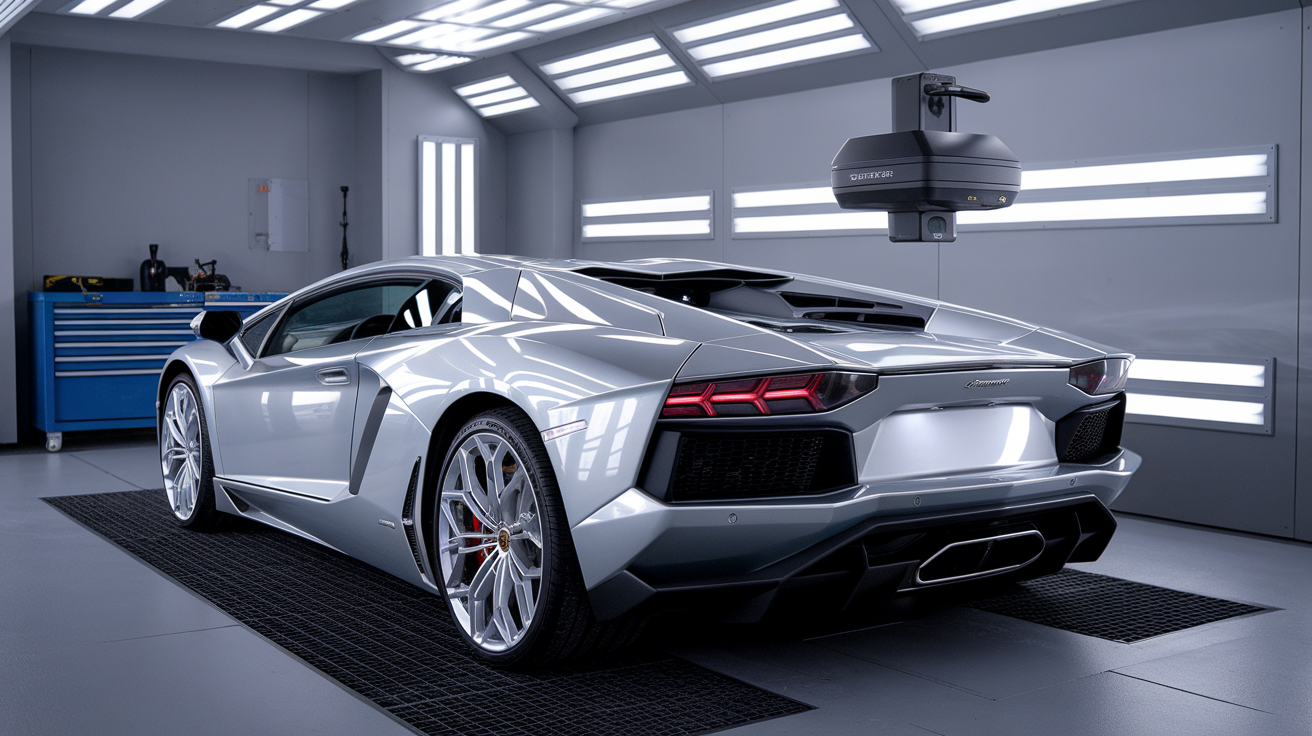
5 | Precision Multi-Axis Frame Scanner
When a supercar takes a hit, damage is rarely visible on the surface. Beneath the paint lies a complex chassis that reacts differently than standard steel. This multi-axis frame scanner uses laser triangulation and 3D blueprint comparison to detect internal misalignments, even when there are no outward signs. It builds a digital twin of the frame in seconds.
In one Dubai project, we used it to verify a suspected twist in a Ferrari 812 chassis after a track spin. Turns out, there was a 3.5mm skew in the rear subframe, completely invisible without this scanner. That is the level of detail Supercar Body Shop Tools are designed for.
Supercar Body Shop Tools like this eliminate guesswork, confirm factory tolerances, and let us plan repairs with data, not gut feeling. For modern frames, digital precision is not optional. It is survival. Suspect deeper structural issues? Run through our car chassis repair checklist before any pull or correction.
6 | High-RPM Orbital Compounding Polisher
A swirl mark on a Corolla is cosmetic. On a Bugatti? It is unacceptable. This high-RPM orbital compounding polisher delivers controlled speed, low torque, and variable heat to correct paint without burning through thin multi-layer coatings. We use it on ceramic-coated, soft-clear, and matte finishes, especially where hand-polishing would fail.
One small job on a Rolls-Royce Phantom in Dubai involved removing deep scratches from a narrow coachline without affecting the surrounding mirror finish. This tool handled it flawlessly. Its dual-action motor mimics hand movement but adds speed and consistency that no human can match. Supercar Body Shop Tools like this are built for fragile, factory-grade finishes. Over-polish once, and you are respraying an entire panel at 15,000 AED or more. We trust Supercar Body Shop Tools like this polisher when appearance, depth, and gloss are not negotiable; they are the finish line.
7 | Low-Torque Alloy Rivet Gun
Supercar panels are often bonded or riveted, not welded. Especially with aluminum structures, applying the wrong force means crushed panels or misaligned sections. This low-torque alloy rivet gun delivers consistent pressure without distorting lightweight materials. It is designed for structural and cosmetic rivet installs across body shells, side skirts, and inner frames.
We once used this tool during a Bentley Continental GT rear quarter panel rebuild. The original fasteners were specialty rivets, and this gun replicated the factory seal without over-pulling or deforming the alloy. That level of control is non-negotiable in our Dubai shop.
Supercar Body Shop Tools like this rivet gun allow for precise fastening in fragile areas, especially where adhesives and rivets work together. It balances grip with protection. You simply cannot work on bonded structures without Supercar Body Shop Tools that respect the materials as much as the engineering.
8 | Carbon-Safe Air Sander
You cannot sand carbon fiber the same way you sand steel. One wrong move, and you burn through the top resin layer, ruining the part entirely. The carbon-safe air sander is designed with adjustable pad pressure, controlled speed, and integrated dust extraction to safely prep carbon panels without damaging the weave.
In Dubai, we regularly use it on Lamborghini front splitters and McLaren side skirts, where even minor over-sanding shows up under clear coat. The precision of this tool allows smooth surface prep while maintaining structural integrity.
Supercar Body Shop Tools like this are engineered to work with advanced materials, not against them. That means no guesswork, no damage, no cutting corners. When we handle exposed weave carbon or ultra-light panels, this sander is the difference between finish-ready and factory rejection. It is one of those Supercar Body Shop Tools we never risk a day without.
9 | Ceramic Coating Infrared Curing Lamp
Ceramic coatings on supercars are not just about shine; they are protection. But curing them? That is where most body shops fall short. This infrared curing lamp heats coatings evenly, activating chemical bonds without blistering or uneven hardening. It’s height-adjustable, angle-controlled, and calibrated to avoid damaging thin clear coats on luxury paintwork.
We use it frequently on freshly detailed Bugattis, Maybachs, and Porsches, where delivery deadlines are tight. In Dubai’s climate, ambient curing is unreliable. This lamp ensures uniform hardening, zero hazing, and maximum longevity. Without Supercar Body Shop Tools like this, you are just applying and praying. That does not cut it with ceramic. This is one of those Supercar Body Shop Tools that helps us finish jobs faster, better, and with finish integrity intact, even under a Dubai deadline.
10 | Electronic Spot-Welder with Heat Feedback
Welding aluminum on a supercar is not about melting metal; it is about managing heat. This electronic spot-welder uses pulse-controlled current and real-time thermal feedback to join panels without distorting lightweight frames. It reads surface temperature mid-weld, adjusting output instantly to prevent burn-through.
We used this on a Mercedes-AMG GT rear apron, where factory seams demanded OEM-level accuracy. The result? Seamless, ripple-free bonding with zero warping. That’s what separates ordinary welders from tools that respect design integrity. Supercar Body Shop Tools like this are made for thin-gauge materials and complex multi-metal sections. Precision welding on exotic frames is impossible without Supercar Body Shop Tools that think faster than the human hand.
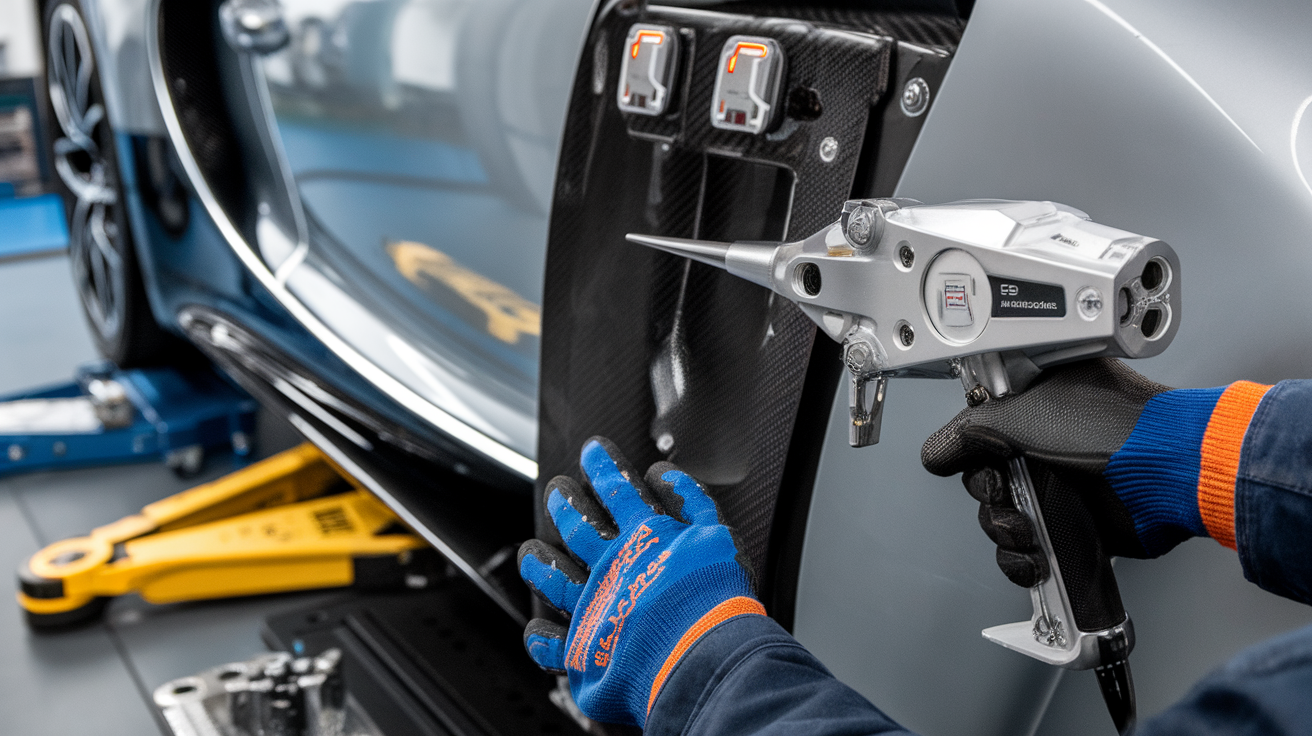
11 | Paint-Match Spectrometer Device
You cannot match supercar paint by eye, not when it involves pearl layers, color-shift flakes, or multi-stage metallics. This paint-match spectrometer device scans the paint surface and breaks down its spectrum digitally. It then compares the result to factory databases to generate an exact match, even in Dubai’s shifting sunlight.
We’ve used it to blend panels on a Ferrari 296 GTB where one side had faded from desert exposure. The match was so precise, even the client could not tell where old ended and new began. Supercar Body Shop Tools like this remove the guesswork and preserve the car’s resale value. No more shade mismatches or respraying entire sides. With Supercar Body Shop Tools like this spectrometer, we restore color the way the factory intended. Want to see how application gear affects finish quality? Don’t miss our HVLP spray guns guide.
12 | Clean-Room Panel Assembly Station
Dust, humidity, or even a fingerprint can ruin final assembly on a supercar, especially when sealing carbon panels or installing interior trim. That is why we use a clean-room panel assembly station. It is a climate-controlled, anti-static workspace built to protect delicate components during reassembly.
We used this setup during a complete panel refit on a Pagani Huayra flown in from Europe. From fender liners to rear clamshells, every part went on in a sealed, sterile bay, no airborne dust, no mishandling. Supercar Body Shop Tools like this ensure no contaminants interfere with fitment, bonding, or electronics. This station is where precision meets respect. And it is one of those Supercar Body Shop Tools that proves final touches matter just as much as the first pull.
Supercar Tools vs Standard Tools | Why It Is Not Even Close?
Let’s be honest, there is no real comparison. Trying to fix a carbon monocoque with regular frame jigs is like performing brain surgery with a butter knife. The gap between Supercar Body Shop Tools and standard garage equipment is not just wide, it is dangerous. Here is how they differ, plain and simple:
- Precision | Supercar tools operate within sub-millimeter tolerances. Standard tools? Not even close.
- Material Handling | Aluminum, carbon fiber, magnesium, all need specialized tech. Generic tools warp them.
- Heat Control | Tools with thermal feedback prevent microfractures. Regular welders? Blind heat.
- Digital Integration | Laser mapping, spectrometer matching, scanner syncing, none of that exists in budget shops.
- Finish Standards | You do not just aim for “close enough.” You match factory perfection.
We had a Porsche GT3 come in last month, previously repaired using sedan-grade tools. The panels were slightly misaligned, but enough that air was whistling through the A-pillar at 85 miles per hour. We redid the entire fitment using our Supercar Body Shop Tools, restoring it to showroom condition. The takeaway? If your body shop is not using Supercar Body Shop Tools, it is not really equipped to handle supercars.
What Happens When These Tools Are Missing?
Let’s skip the theory. We’ve seen the damage, literally. One McLaren 720S came to our Dubai bay after a poorly done fender job. The shop used regular clamps and sanding tools. The result? A hairline fracture in the carbon structure, visible only under polarized light. That tiny mistake turned into a 140,000 AED replacement job. Supercar Body Shop Tools are not a flex; they are the only safe way to work on these cars. When shops skip them, things go wrong:
- Panels misalign and whistle at speed
- Paint mismatches under showroom light
- Rivets deform fragile aluminum edges
- Heat warps composite parts beyond repair
One missing tool can turn a routine job into a financial disaster for both the shop and the client. And in a place like Dubai, word spreads fast.
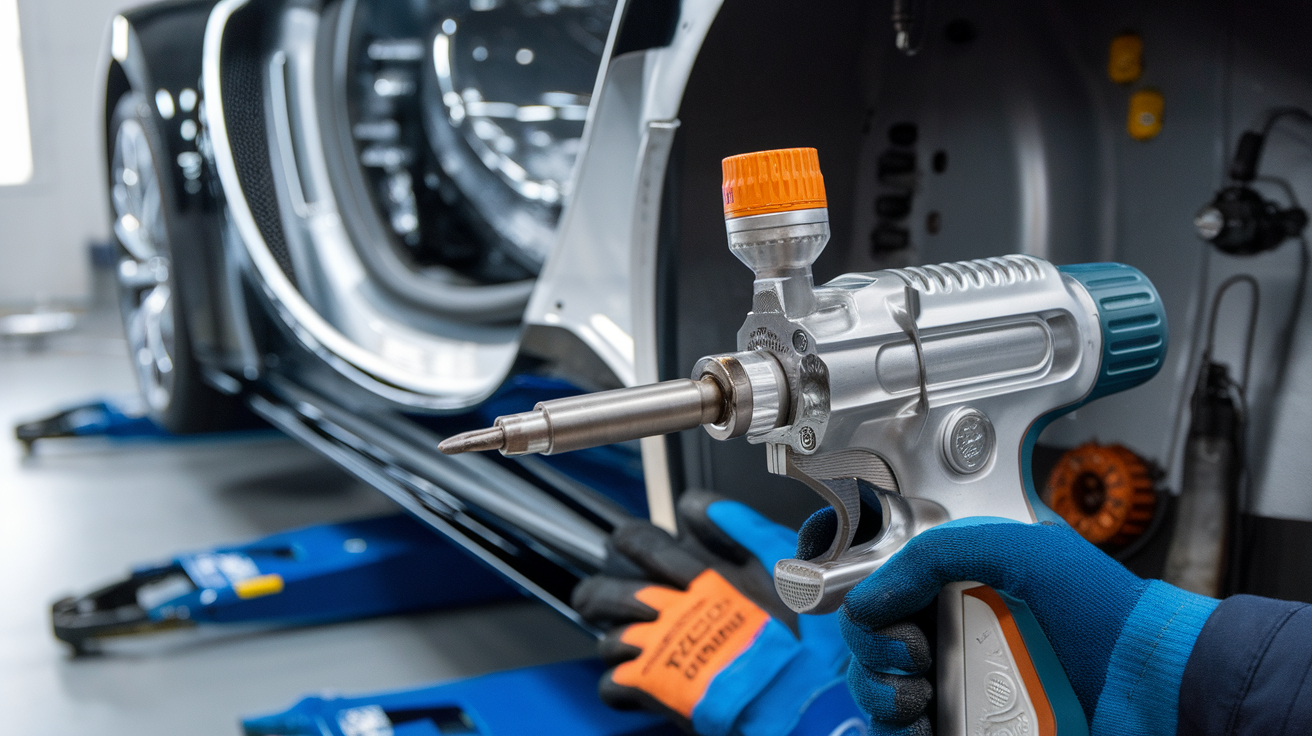
How Each Tool Earns Its Place in Our Shop?
We do not just buy tools because they look advanced; we test them, break them in, and evaluate their output on real repairs. Every item in our Supercar Body Shop Tools lineup earns its space by proving one thing: it solves a specific problem better than anything else. Some tools save time. Some prevent rework. Some protect against six-figure mistakes. But none of them are shelf decoration. Here is how we think:
- Does it reduce risk when working with exotic materials?
- Does it replicate or exceed factory methods?
- Can we trust it on a one-off body shape?
- Will it help us pass insurance audits or resale inspections?
Every tool on our list has a story behind it, usually one that involved a tough job and a tight deadline. That is how tools become trusted.
Dubai Repairs That Proved the Tools Are Right
We once had a Koenigsegg Agera arrive from a private collector. It had damage near the rear aero panel, a mix of carbon weave and bonded aluminum. No shop in the region wanted to touch it.
Using our Supercar Body Shop Tools, we scanned the frame, aligned the panel digitally, re-bonded with zero ripple, and cured the finish without a hint of sanding haze.
Another case? A Ferrari SF90 with ceramic coating damage on just one door. We cured it using our infrared lamp without affecting the rest of the panel, impossible with handheld methods.
Why Investing in These Tools Pays Off for the Client?
For the car owner, it’s not about what machine we use. It is about results. No resprays. No squeaks. No do-overs. But those results only come from tools built for the job. Every one of our Supercar Body Shop Tools helps reduce unnecessary panel replacements, speeds up repair without skipping quality, and maintains factory integrity. That means:
- Lower downtime | Cars are back on the road faster
- Higher resale value | No questionable repairs that raise flags
- Peace of mind | They know the tools used were made for their car
Supercar owners expect perfection. These tools are how we deliver it.

